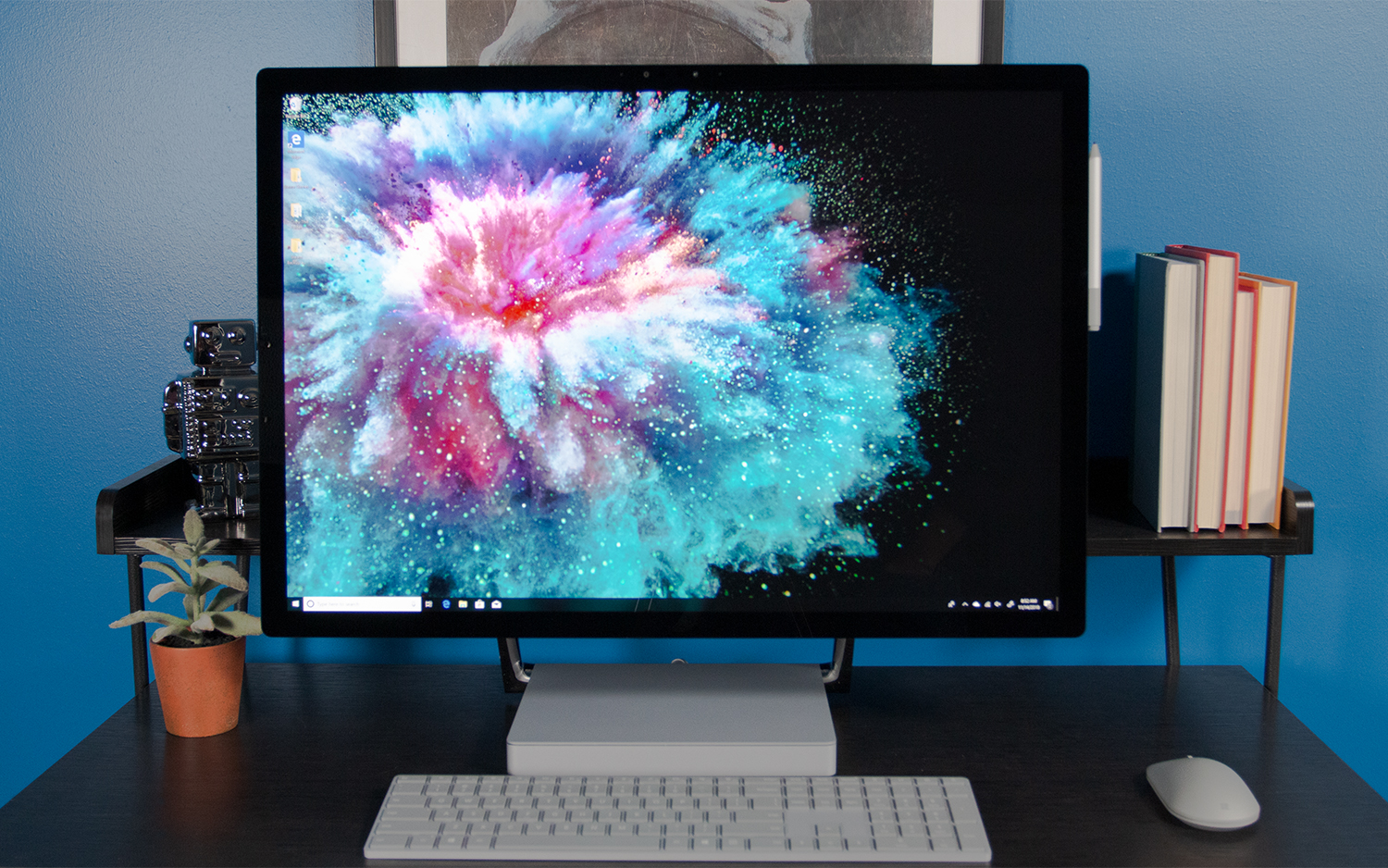Tom's Guide Verdict
The Microsoft Surface Studio 2 is the best touch-screen all-in-one you'll find for drawing and digital creation, but even with updated hardware, this device is not as amazing the second time around.
Pros
- +
Excellent design lets you use as a desktop or drawing board
- +
Flexible hinge
- +
Excellent display quality
- +
Strong audio
- +
Best-in-class pen support
Cons
- -
Pricey
- -
Inconvenient port placement
- -
Hardware is dated from the start
Why you can trust Tom's Guide
Microsoft's Surface tablets and laptops may be well-known, but for artists and creative pros, there's only one Surface PC to consider: the Microsoft Surface Studio 2 ($3,499 to start, $4,199 as reviewed). This is the latest version of the touch-centric all-in-one desktop.
We loved the first version of the Surface Studio, thanks largely to its beautiful PixelSense display, easy-to-reposition hinge design, superb pen support and strong overall performance. The 2018 model gets beefier processing and graphics hardware, switches to all-solid-state drives for storage, and gets an even better version of the PixelSense display that offers enhanced brightness and contrast. It's one of the best all-in-one computers — and one of the best computers period — we've seen, and our top pick for media creators and artists.
Design
The Surface Studio 2 has the same exterior design as the original 2017 model, but that's no knock. The Surface Studio may not be as well-known as the iconic iMac, but the design is easily one of the most refined of any all-in-one I've reviewed. Measuring 25.1 x 17.3 x 8.7 inches and weighing 21 pounds, the Surface Studio is superlative in its design. All of the usual terms reviewers use to describe a great-looking product — sleek, sexy, polished, elegant — apply in spades. But the biggest thing to note about the design is that it's useful, in a way that very few all-in-one systems can match.
The touch-screen panel is mounted on what Microsoft calls a "zero gravity hinge." This spring-assisted, dual-hinge stand lets you put the screen upright for traditional desktop use or down low for more-comfortable use of the stylus and touch screen.
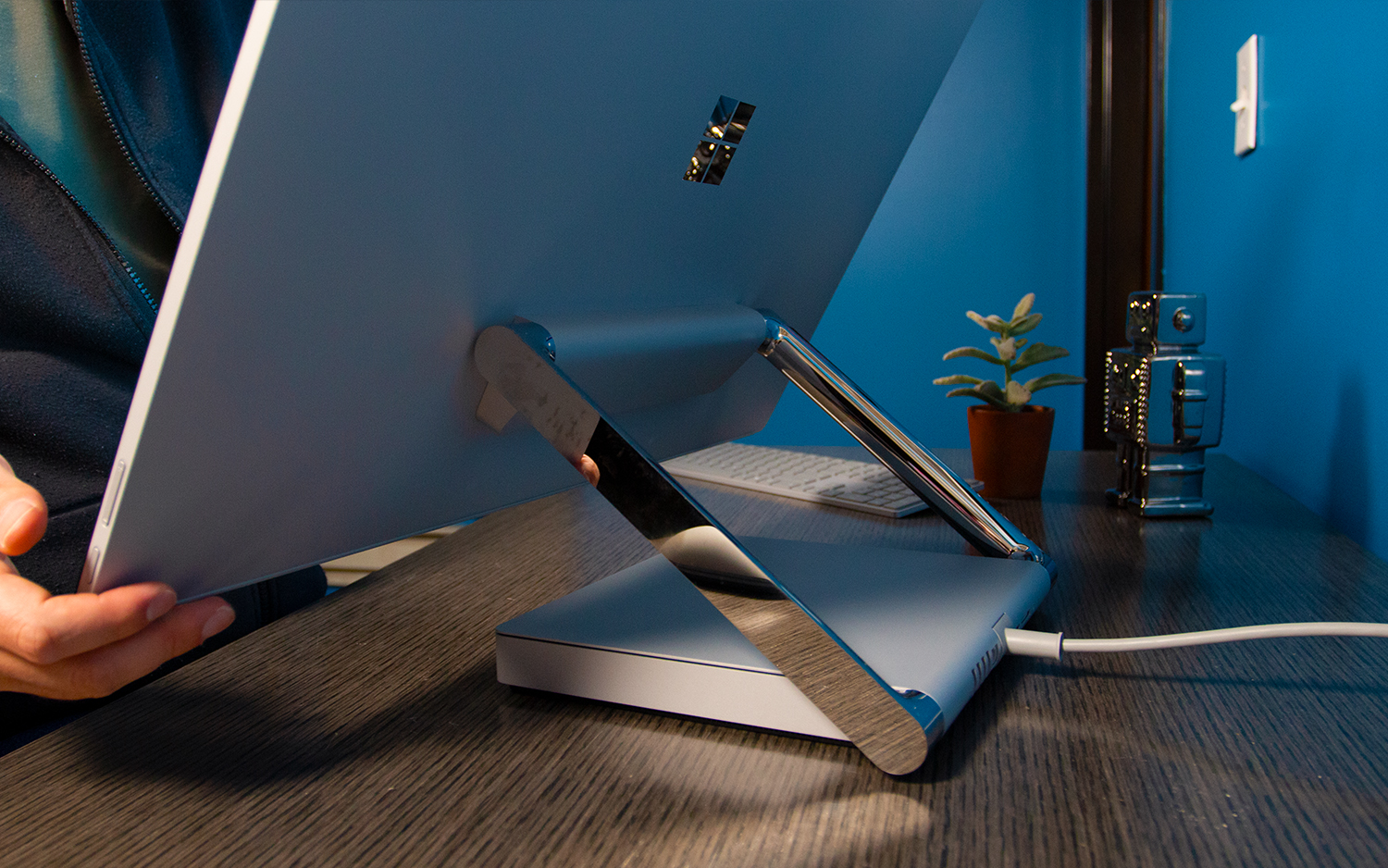
The low angle puts the screen into a position similar to that of a drafting table, making extended stylus use both comfortable and efficient. The hinge also allows for both angle and height adjustments.
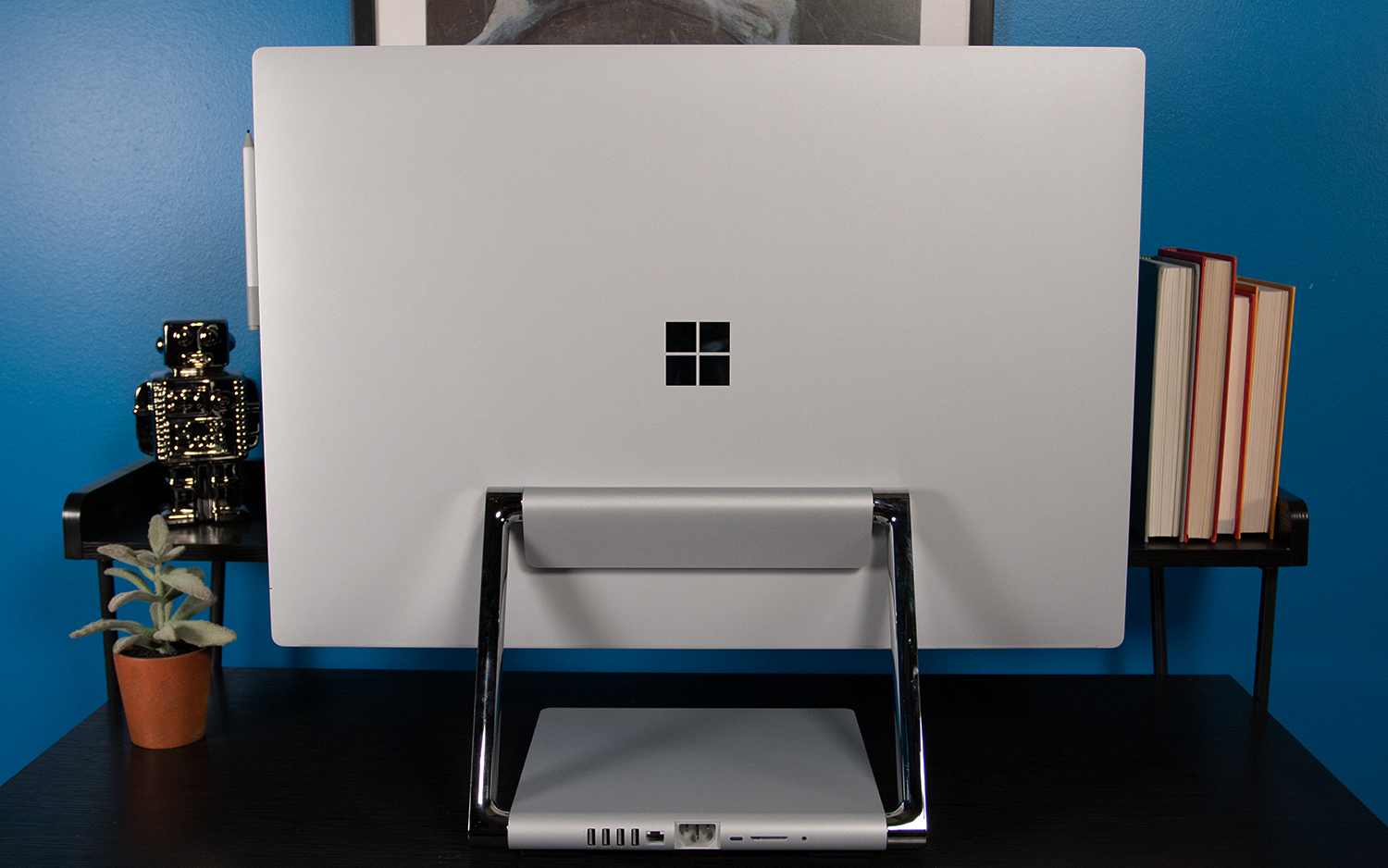
One odd quirk of the zero gravity hinge is that the angle and height are linked, so you can put the screen upright when it's raised and at an angle when it's lowered, but the angle self-adjusts as you raise or lower the display. As a result, it's not as adjustable as many all-in-ones that offer only angle adjustment, such as the Apple iMac, because adjusting the angle, by necessity, will also change the height.
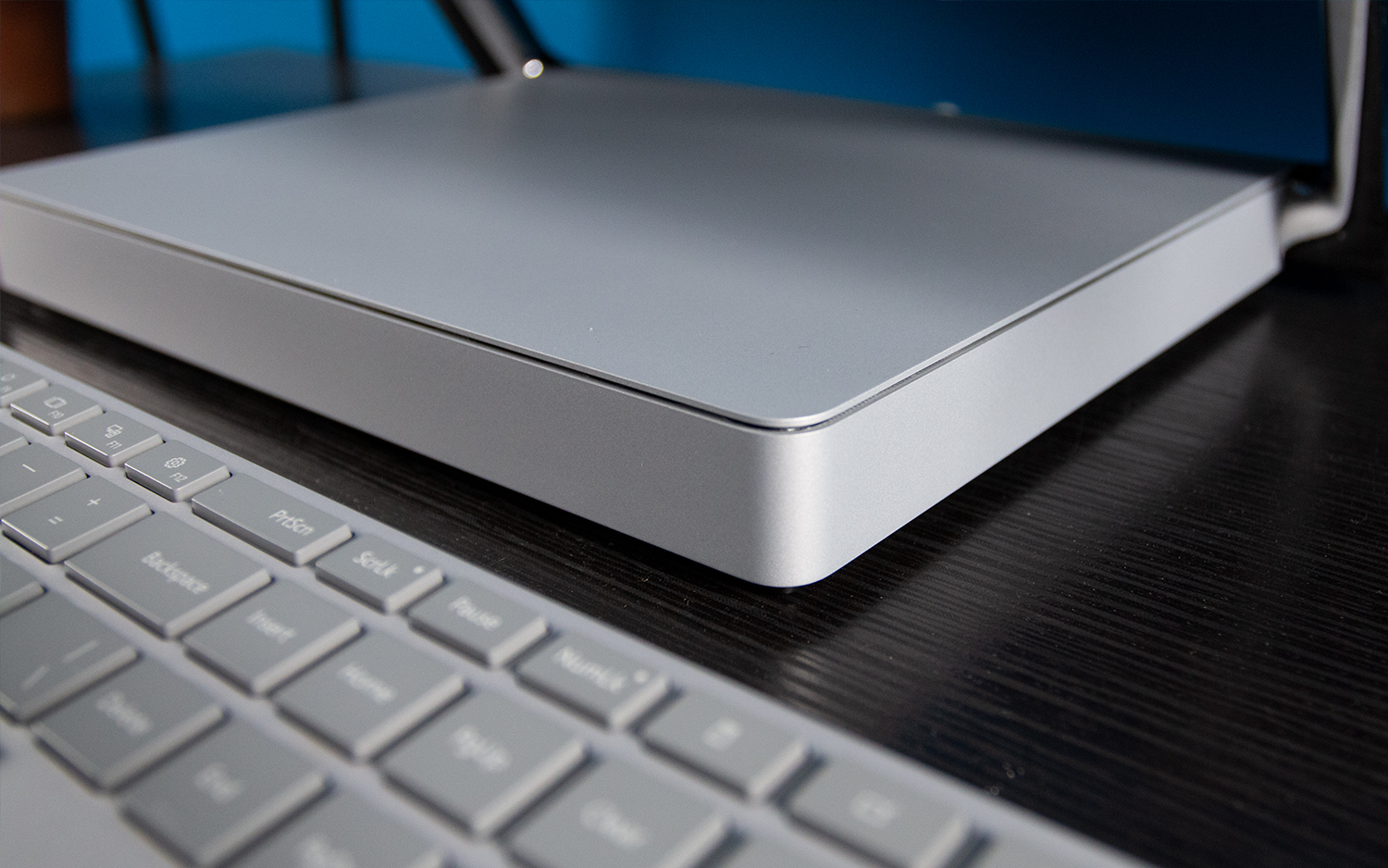
The PC components are housed in the base of the stand, a squarish box that measures 9.8 x 8.7 x 1.3 inches. The base is square, with rounded corners and a rounded rear end that also has all of the PC's ports. Putting the internals into a separate base like this keeps the display slim and unencumbered by extra bulk, so it measures just 0.4-inch thick.
Display
Displays are always an important part of an all-in-one, but Microsoft has gone to great lengths to make the Surface Studio 2 a display-first experience, leveraging the extensive touch support of Windows. In addition to 10-point multitouch support, the Surface Studio 2 comes with a Surface Pen, offering superb stylus input that boasts 4,096 levels of pressure sensitivity and tilt support. The result is an extremely natural-feeling experience as you draw and write on the screen.
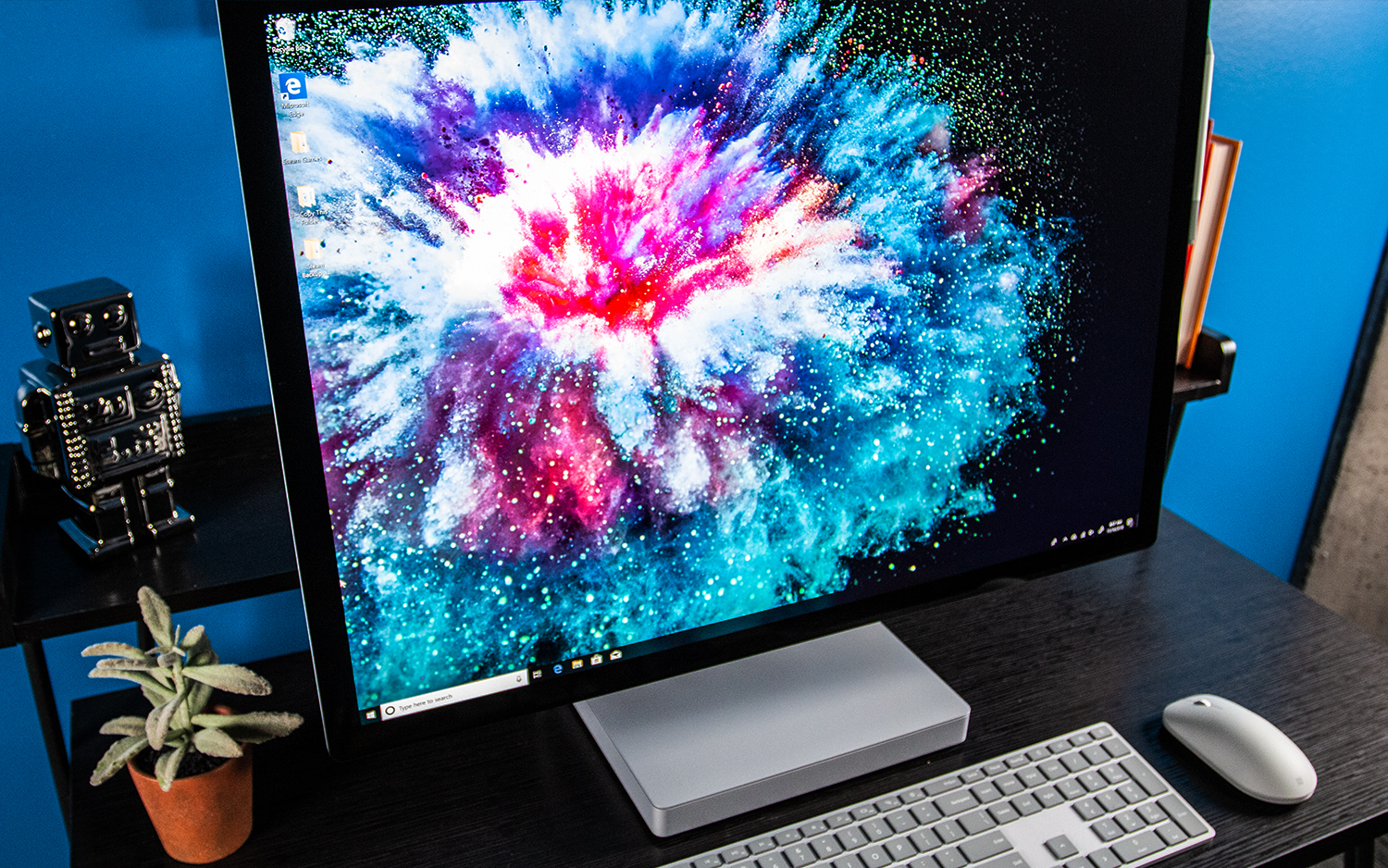
The 28-inch display isn't quite like any other all-in-one we've reviewed. The 28-inch panel has a 3:2 aspect ratio, instead of the more common 16:9 displays used on most all-in-ones. It's a bit more square in shape, but the real draw is that it matches the 3:2 aspect ratio of 35mm film for photographers; offers a better reading experience for websites, digital books and magazines; and is more comfortable than anything that uses on-screen handwriting, like Microsoft OneNote.
Watching the 4K demo video for Cyberpunk 2077, I was impressed with how clearly the colors came through. Whether it was a dark warehouse meeting with some cyborg thugs or a daylight negotiation with a nameless corporate player, the details were clear and the colors were vivid. This may be one of the most beautiful displays I've seen.
Testing with our Klein K-10A colorimeter put some numbers to our first impressions. In Vivid mode, the Surface Studio 2 reproduced 167 percent of the sRGB color gamut, which matched the Apple iMac's output (167 percent) and was better than the Asus Zen AiO Pro Z240IE's result (146 percent). But while it's a strong showing, the Studio 2's result actually falls slightly behind that of last year's model, which displayed 181 percent of the color gamut under the same settings.
The new device's display is one of the most accurate we've seen, with a Delta-E rating of 0.13 (closer to zero is better). This is an improvement over the result from last year's model (1.0) and puts the Studio 2 alongside some amazing competitors, like the Dell XPS 27 7760 (0.11) and the Apple iMac Pro (0.38).
MORE: All-in-One PCs - Reviews, News and Our Top Picks
The brightness is also strong, with this display averaging 456 nits at peak levels. That puts it right alongside some of the brightest displays available on an all-in-one, like the display on the Apple iMac (463 nits). That score also makes the Studio 2 brighter than the previous Surface Studio (354 nits) and dramatically brighter than both the Asus Zen AiO Pro Z240IE (247 nits) and the Dell XPS 27 7760 (344 nits).
From a technical perspective, the Surface Studio's PixelSense display — Microsoft's answer to Apple's Retina branding — has some serious chops. The resolution of 4500 x 3000 goes above and beyond 4K Ultra HD (3840 x 2160), and this is the only all-in-one display we've seen effectively challenge the Apple iMac's 5K display.
Each display is color calibrated before it's shipped, so display quality is at its best right out of the box. And Microsoft touts the built-in color settings, which are optimized for sRGB, DCI-P3 and Vivid color modes. What I didn't see support for is the Rec. 2020 standard, which would be needed for real HDR capability. As video and photo editors increasingly work with HDR content, it's disappointing to see the Surface Studio omit this standard.
For those who absolutely need HDR support, however, the Surface Studio can run a secondary display (via USB-C), and it does output HDR-enabled video. You'll just need to provide your own HDR-capable display.
The glass on the display is also very reflective, catching glare from overhead lights and presenting users with mirror-like reflections in both desktop and drawing positions. While this screen looks great for most applications, I'm sure that many artists and photographers, ostensibly the target market for the Surface Studio, would prefer a matte display.
Audio
Audio quality is also quite good, though the competition is just as fierce. The Studio has eight speakers built in to the display and another two in the base, and it delivers Dolby Audio Premium sound. When I listened to the song "Spoiler" by Hyper, the Surface Studio offered high-quality audio, with clear channel separation and crisp clarity.
The only ways to get better sound would be to add a set of external speakers or opt for an all-in-one, like the Dell XPS 27 7760, that places a much larger priority on audio.
Keyboard, Mouse and More
As with most all-in-one PCs, the Surface Studio 2 comes with a keyboard and mouse. Both connect over Bluetooth and match the design aesthetic of the PC itself.
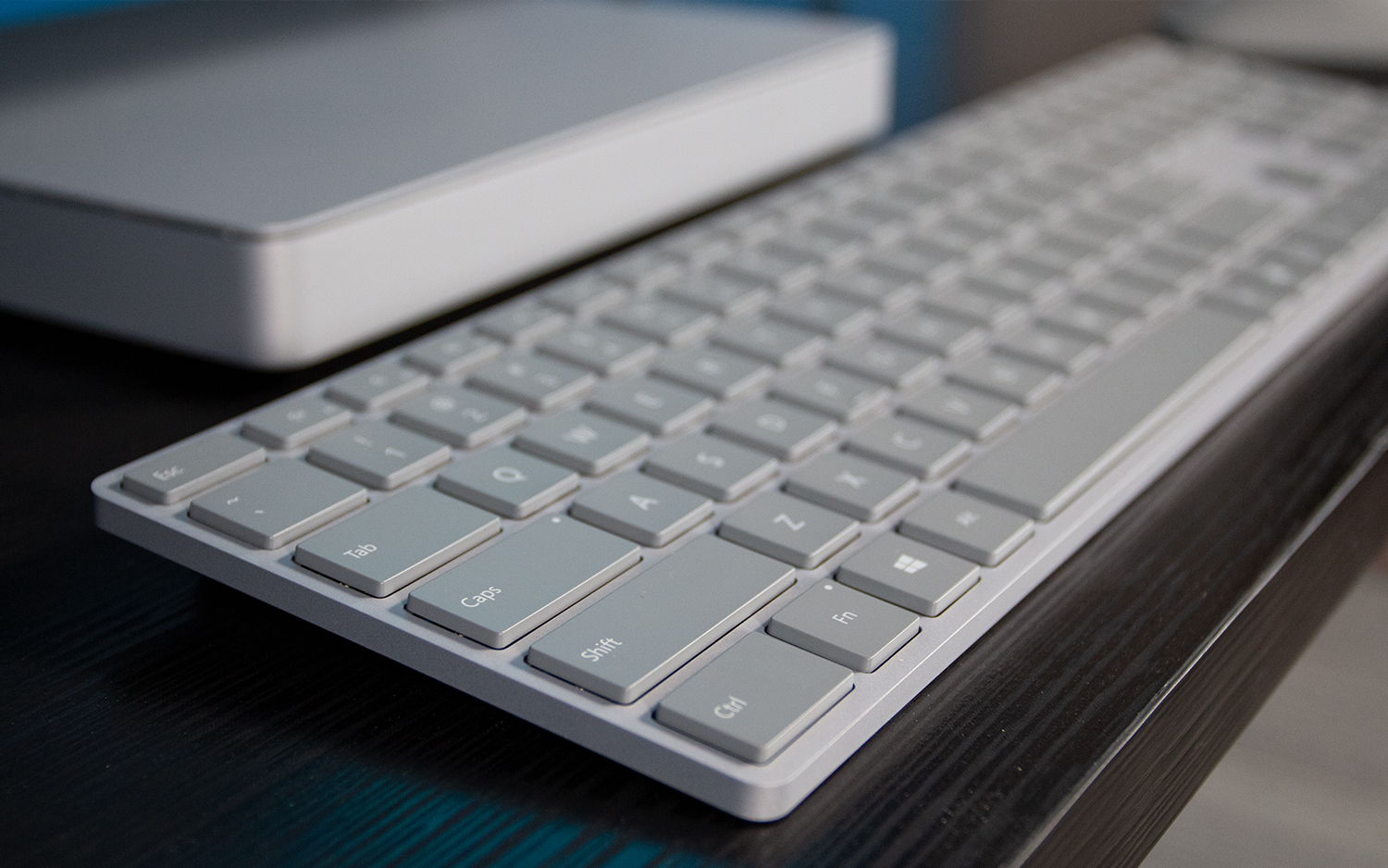
The Surface Keyboard has a low-profile design, with tile keys. The gray-on-gray color scheme looks great, and the keyboard offers a very comfortable typing experience. Compared to the Apple Magic Keyboard, for example, the overall look is similar, but the individual keys feel more substantial, with better stabilization and deeper key travel.
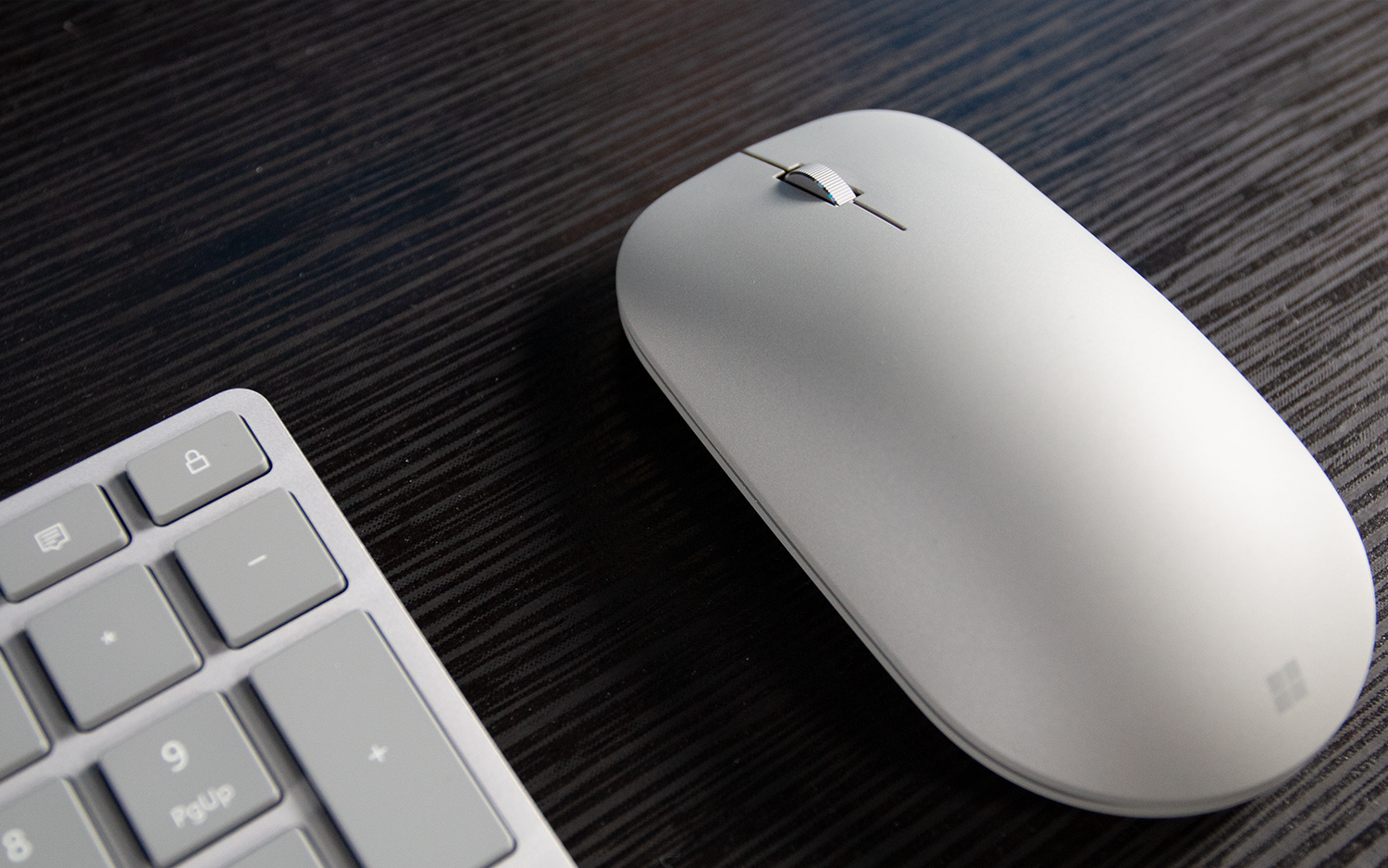
The Surface Mouse has the same gray color scheme, which matches the metal exterior of the Surface Studio's base. This mouse's curved profile is one of the most visually sophisticated designs of any included mouse, but it's still a basic wireless mouse.
The Surface Studio 2 comes with something extra: the Surface Pen. More than just a stylus, the pen has wireless connectivity, a built-in eraser and tilt support. The addition of tilt support, along with the 4,096 levels of pressure sensitivity, makes using the pen an extremely natural-feeling experience.

There also very little lag. It's the sort of thing you don't even think about under most circumstances, but when you routinely use pen input on a PC (either on the screen or with a Wacom tablet), you grow accustomed to seeing the path of a sketched line trail your pen slightly. The Surface Pen is better than most in that regard.

Drawing on the display is exact and intuitive, with excellent accuracy and control. Whether I was writing by hand or sketching a quick doodle, the pen input was more like drawing on paper than with any other stylus or connected pen I've used.
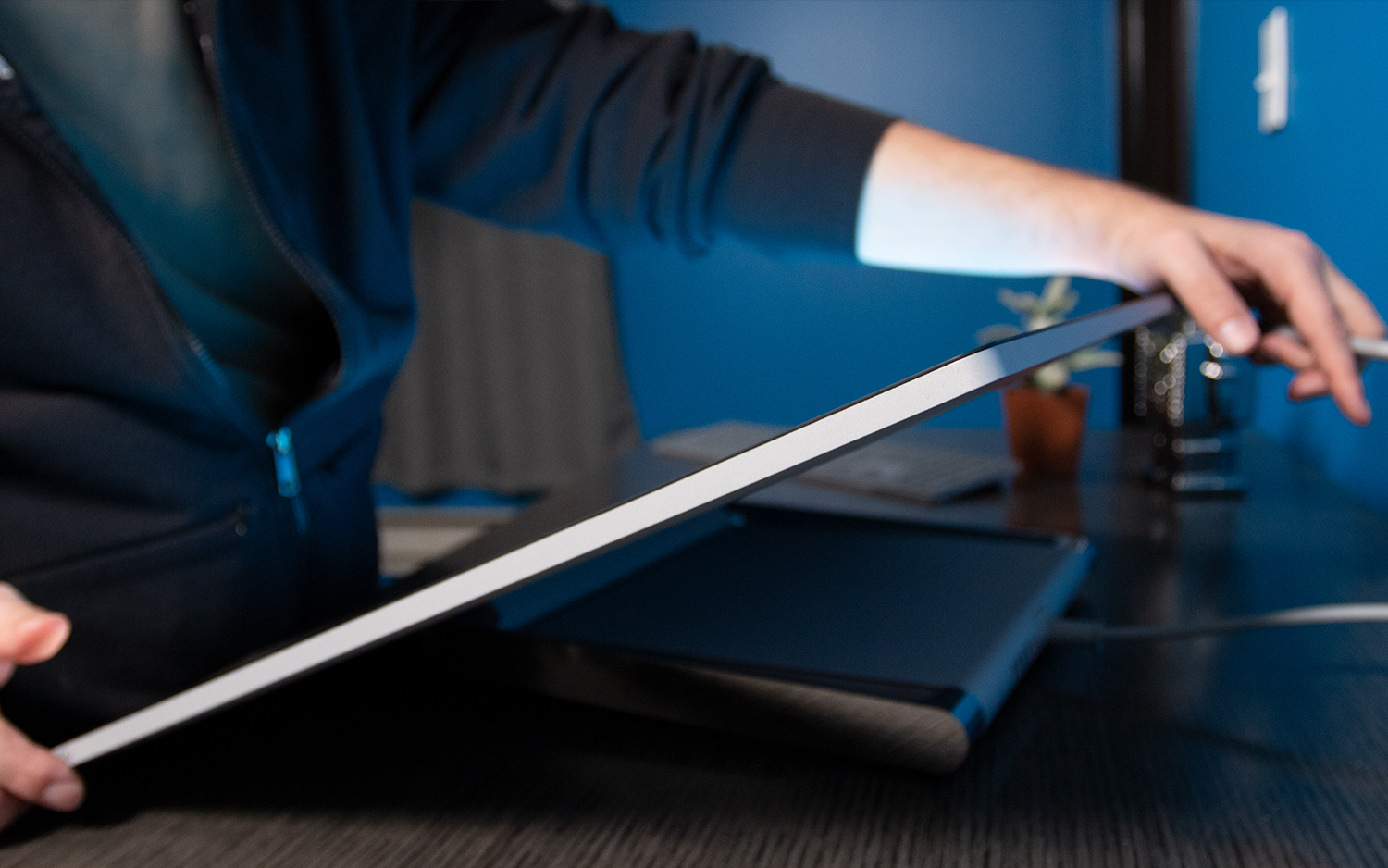
The Surface pen connects via Bluetooth and is powered by a single AAA battery, which is included. This stylus is also easy to keep track of thanks to a magnetic holder built in to the right- and left-hand sides of the display chassis.
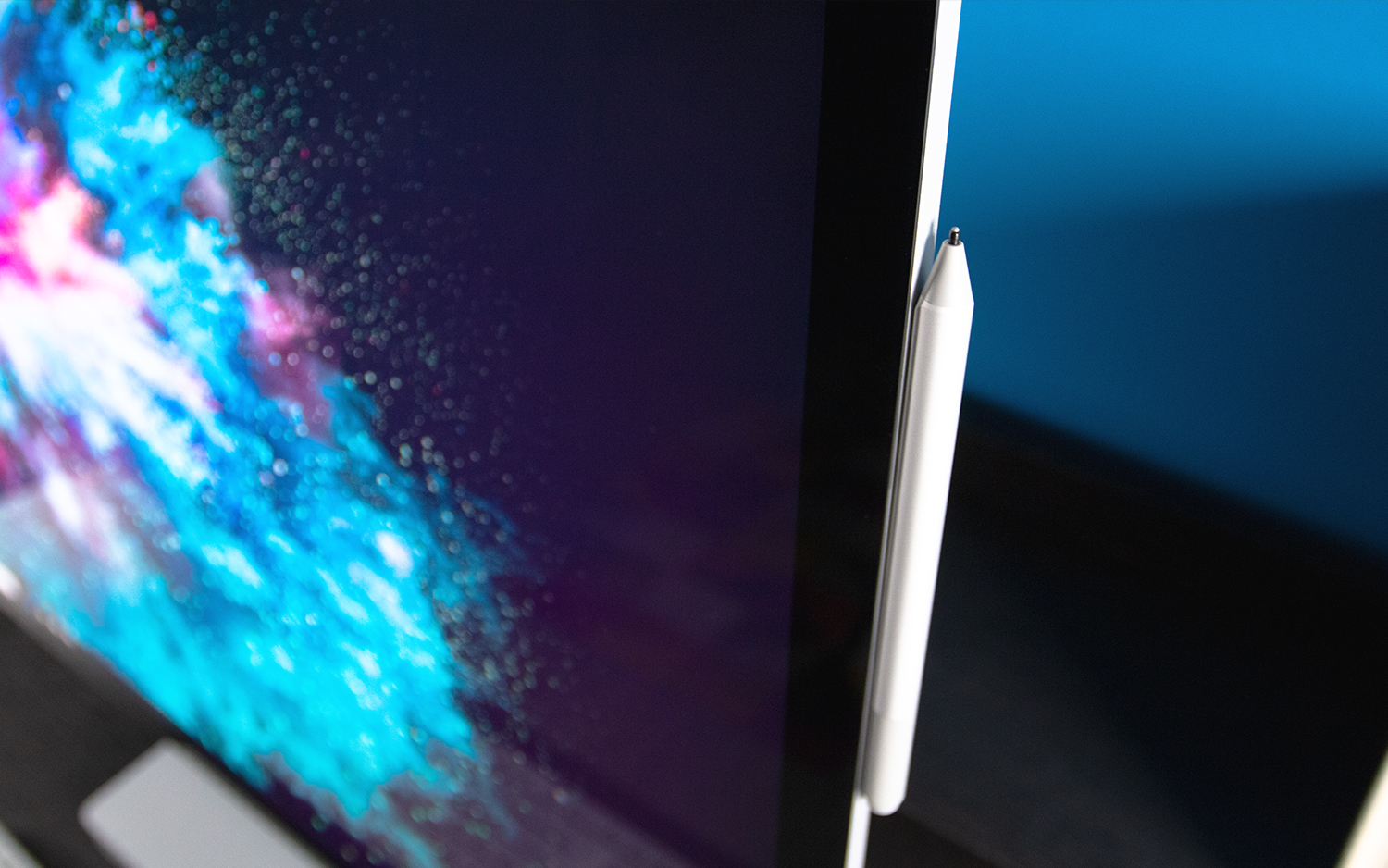
One additional accessory unique to Microsoft's own brand is the Surface Dial. This is sort of its own thing, a round, metal-surfaced knob designed to provide an easy, tactile way to cycle through options or scroll back and forth through media (like recorded audio or video) with ease and precision. Though this accessory wasn't part of this review, I've used the Dial a handful of times, and I've always been impressed. But it doesn't come standard with the Surface Studio 2. Instead, if you want to add a unique peripheral in the Surface family, you'll need to buy the Dial separately, for an extra $99.
Finally, if you want to use an Xbox One controller with the Surface Studio 2, you're in luck: Microsoft has also built in Xbox wireless support. You can even use the controller with the Dial's palette-style menus for art and media editing, giving you an interesting productivity use for your game controller.
Ports
The Surface Studio's square-shaped base has a rounded back end, which matches the curve of the bottom hinge on the stand. Set into that curved rear face, you'll find four USB 3.0 ports, one USB Type-C port, a full-size SD card reader, a Gigabit Ethernet port and a 3.5mm jack for sound.
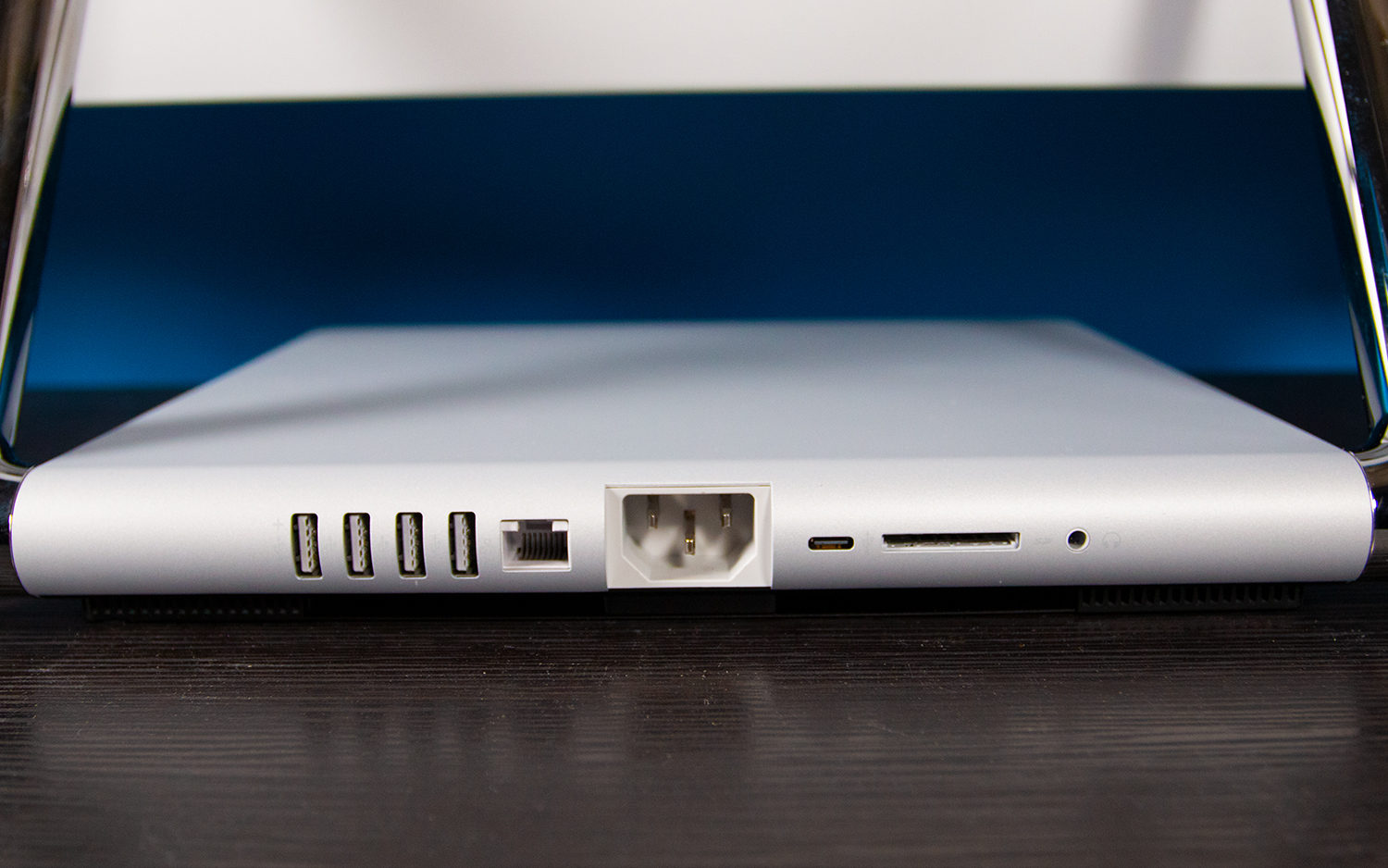
The selection of USB ports offers plenty of connectivity for wired peripherals, but we do wish that there were more than one USB-C connection — or even better, if the Studio 2 offered Thunderbolt 3 connectivity. Such a connection would also enhance the capability of the machine for media pros, who could add external graphics cards if they need more-substantial graphics capability.
But the much larger issue is port placement. With all of the ports on the back of the machine, and with the unusual curved surface on that rear panel, the Surface Studio's ports are hard to reach and make it more difficult than usual to blindly plug things in.
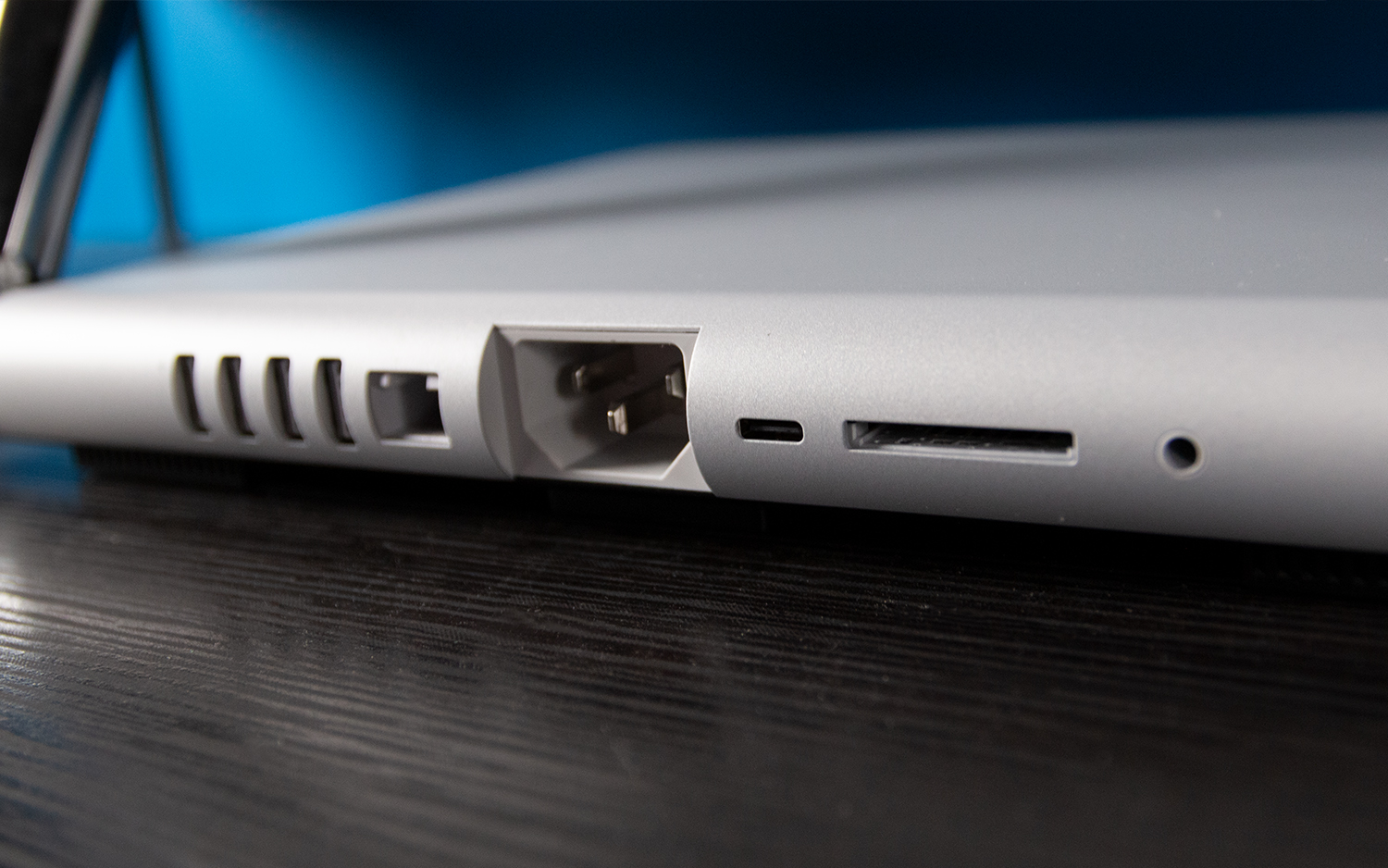
But that inconvenient port placement is less of an aesthetic choice and more of a design necessity. When the display is positioned low for drawing and pen use, the pivoting arms of the stand come down parallel with the sides of the base, making side-mounted ports impractical. And the lower screen position would also interfere with any plugged-in peripherals in front, precluding any front-facing ports. The result: All of the ports are on the back side of the base, requiring you to turn the entire system for port access. If you find the port placement to be a real inconvenience, you can get some additional flexibility with a USB hub or similar solution.
Performance
Our review unit was the midtier version of the Surface Studio, which is outfitted with an Intel Core i7-7820HQ CPU, 32GB of RAM and a 1TB solid state drive. The processor is a full-fledged quad-core desktop CPU, unlike the laptop-class models used in lower-end all-in-ones. But it's also on the older side, a 7th-Generation processor when 8th-Generation processors are readily available. It still offers plenty of processing power, and there's no immediate detriment to performance, but it's likely to show its age sooner than systems equipped with more-current hardware.
When using the Surface Studio, I was able to run more than 30 simultaneous browser tabs in Microsoft Edge (the Surface Studio's default browser), while also streaming music and watching movie trailers in 4K. At no point was there a hint of slowing down or struggling to keep up as I switched between tabs.
The Surface Studio line has also switched from hybrid drives that pair SSD storage with larger spindle drives to all-solid-state storage. That should deliver a faster experience even when the system's fetching giant files, and it should boost the longevity of the system due to the lack of moving parts. However, in our file-transfer test, the performance was good, not great.
MORE: Best All-in-One Computers - Desktop PCs for Every Budget
The Surface Studio transferred our 4.97GB test folder in 6.24 seconds, at a rate of 815 megabits per second. That puts the Microsoft machine ahead of the Apple iMac 27 inch with 5K (710 MBps) and makes it drastically faster than the Asus Zen AiO Pro Z240IE (101.78 MBps), but it doesn't come close to the category-leading scores of the Dell XPS 27 7760 (1,208 MBps) or the Apple iMac Pro (2,544 MBps). More importantly, it doesn't offer any improvement over the previous model, which completed the same task in 6 seconds (848 MBps).
Overall performance, as measured in our Geekbench 4 benchmark, was strong. The Surface Studio scored 14,971 points, even with an older processor. That's an improvement over the previous Surface Studio model's result (13,197; Intel Core i7-6820HQ) and is better than the Asus Zen AiO Pro Z240IE's score (11,817; Intel Core i7-7700T), but it's far from the best showing out there. The Dell XPS 27 7760 (15,749; Intel Core i7-7700) did a bit better, and the Apple iMac 27 inch with 5K (19,773; Core i7-770K) pushed out even farther ahead.
But the absolute performance champ, with a wickedly powerful Intel Xeon W-2150B workstation-grade CPU is the Apple iMac Pro (36,705). While I wouldn't expect the Surface Studio to beat out the top-specced iMac Pro, Microsoft has thrown around the term workstation in its marketing materials. The company has stopped far short of claiming workstation-grade performance or features like ISV certification, but even bandying the term about suggests a level of performance that the Surface Studio can't deliver. And that's something of a shame, because you'll pay so much more for this machine than any standard all-in-one.
Number-crunching performance is also good on the Studio 2, but far from best-in-class. This machine completed our Excel spreadsheet macro test in just over a minute (1:01), but in our older, OpenOffice version of the test, Microsoft's device took 3 minutes 15 seconds. That's, again, faster than last year's model (3:48) and better than the Asus Zen AiO Pro Z240IE's time (3:40), but the Studio 2 is bested by competitors like the Dell XPS 27 7760 (3:00) and completely outpaced by the Apple iMac (1:57).
Graphics
The Surface Studio is all about content creation, and it delivers thanks to an Nvidia GTX 1070 graphics card with 8GB of VRAM.
On the graphics front, the Surface Studio 2 bested its peers, completing 3DMark Fire Strike with a score of 12,554. That's significantly better than the previous Microsoft Surface Studio's score of just 8,177, as that machine has an older graphics card (Nvidia GeForce GTX 980M, 4GB). The Studio 2 also pulls ahead of the Asus Zen AiO Pro Z240IE (5,383), which has a slightly lower-powered GPU (Nvidia GeForce GTX 1050, 4GB), and the AMD-powered Dell XPS 27 7760 (9,393 with an AMD Radeon RX 570 and 8GB of VRAM).
That also means you've got enough oomph in your content-creation machine to enjoy some gaming in the off hours. The Surface Studio put up playable frame rates in both Rise of the Tomb Raider (50.81 frames per second) and Hitman (94.13 fps), but only at 1080p resolution. Bumping up to native resolution or 4K dropped the frame rates well below the 30-fps threshold needed to actually enjoy a game.
Webcam
The Surface Studio has an integrated webcam just above the display. With 5-megapixel resolution, this machine is capable of 1080p video capture, and depth sensing makes this camera a good fit for Microsoft's facial-recognition tool, Windows Hello. Just set up your security preferences to allow login with Windows Hello, and you'll be able to unlock your system just by looking into the camera.
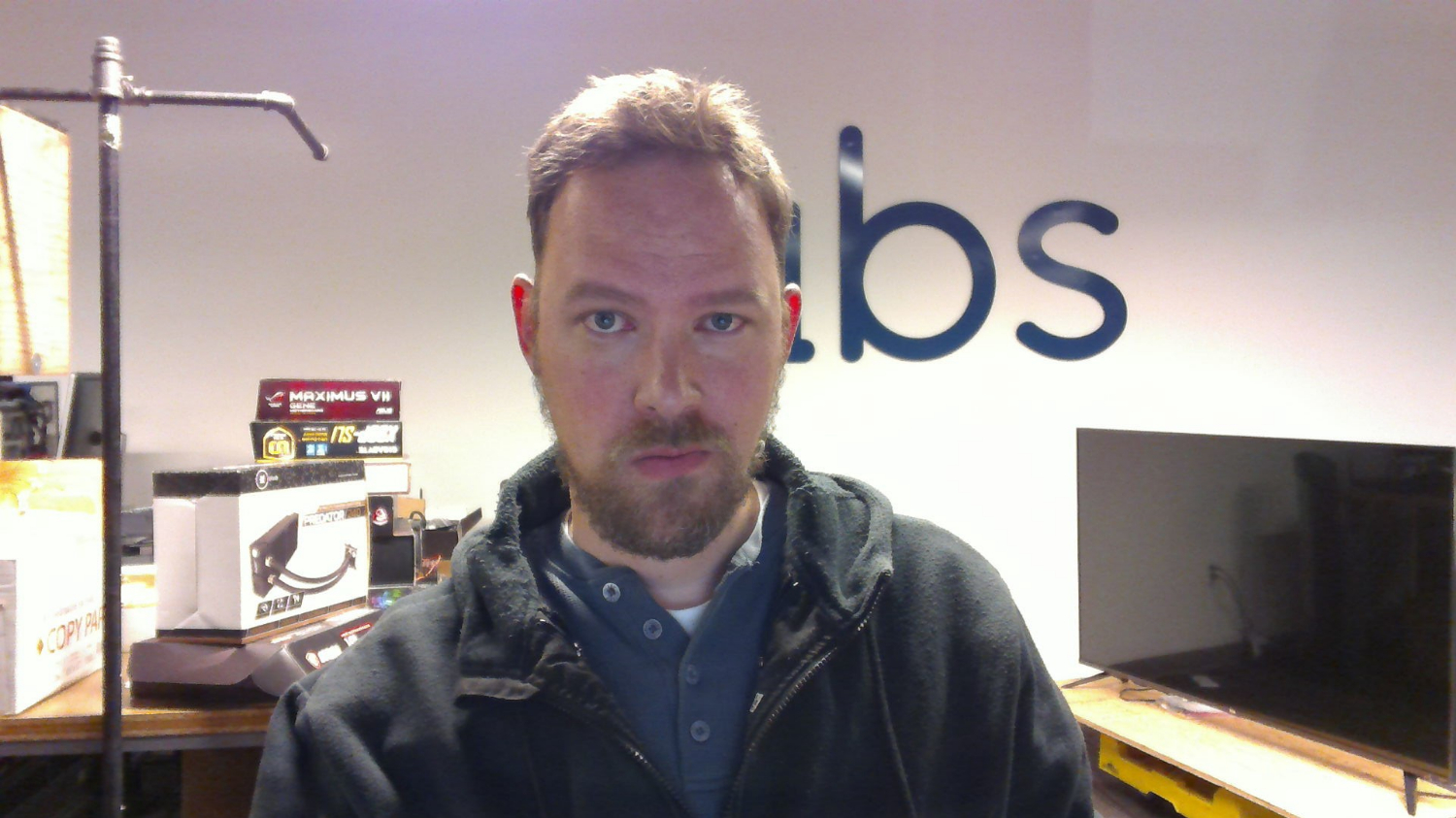
The webcam photo accurately captured my face, with good detail in my hair and beard. However, the brighter portions of the image are a bit washed out, and my cheeks took on a pronounced rosy color that isn’t present in real life.
The system pairs the camera with dual microphones, allowing both improved audio capture as you move in front of the PC and better noise cancellation to filter out ambient noise.
Software and Warranty
As this is a Microsoft product, there was never any doubt that the Surface Studio 2 would come with Windows 10, the latest version of the company's operating system. But what did catch us off guard was the inclusion of a lot of extraneous add-ons, like Minecraft and a collection of solitaire games. You'll get a 30-day trial version of Microsoft Office, including OneNote, as well as Skype, Paint 3D and several other common inclusions. But, by and large, this is a fairly clean installation of Windows, with very few third-party programs.
MORE: Microsoft Customer Service Rating: Undercover Tech Support Rankings
Microsoft covers the Surface Studio with a one-year warranty but beefs it up with several premium touches. You'll get 90 days of free tech support over the phone, a full year of free support and technical help in any Microsoft Store, and even a free 60-minute training session that walks you through all the features and capabilities of the system.
Configurations
The Surface Studio 2 doesn't have a huge number of configurations. In fact, you can customize only three components: the memory, storage and graphics card.
Our review model is outfitted with an Intel Core i7-7820HQ processor, 32GB of RAM and a 1TB SSD for storage, with an an Nvidia GTX 1070 graphics card. This version sells for $4,199.
The more affordable base configuration drops the memory down to 16GB and uses a less powerful Nvidia GeForce GTX 1060 with 6GB of VRAM. That model sells for $3,499.
At the top of the ladder is the a model very like our review unit; it has the same Intel Core i7-7820HQ CPU, 32GB of RAM and Nvidia GTX 1070 GPU. But it doubles the SSD storage to 2TB. That version goes for $4,799.
Bottom Line
When Microsoft introduced the Surface Studio, the company made a bold move, staking out a claim for the traditionally staid Microsoft as the biggest innovator in the PC world. And two years later, the Studio is still a one-of-a-kind machine. The touch and pen capabilities are superb, the display is both beautiful and flexible, and the design is extremely refined. It's easily the most well-designed all-in-one I've ever used on almost every count (except for the port placement, but that's a small quibble).
However, the Studio is not quite as impressive the second time around. The new hardware is slightly dated and slightly underpowered. It's still an impressive machine, with strong performance, but it doesn't have the class-leading power and leading-edge hardware you might expect from Microsoft. The Studio 2 faces tough competition from both the Windows and Apple worlds, and it doesn't always come out the victor.
MORE: All-in-One PC Buying Guide
That said, if you want the hands-down best drawing experience available, the Surface Studio 2 delivers. If you want to ditch your Wacom tablet or expand your hands-on digital artistry, you won't find anything better. There are systems, like the Dell XPS 27 7760, with more horsepower and better sound, and the Studio 2 is on par with Apple's own creative media system, the 27-inch iMac with 5K display. And both of these systems are significantly more affordable.
But the Microsoft Surface Studio 2 does a number of things those other all-in-ones just can't. It's a drafting table, a sketch pad, a canvas and a media studio in one, all on top of being a high-performance desktop PC. If you want the best tool for hands-on content creation, this is it.
Want to bag your next Surface Studio laptop at a cheaper price? Be sure to check out our Microsoft discount codes for the latest ways to save.
Credit: Tom's Guide
Brian Westover is currently Lead Analyst, PCs and Hardware at PCMag. Until recently, however, he was Senior Editor at Tom's Guide, where he led the site's TV coverage for several years, reviewing scores of sets and writing about everything from 8K to HDR to HDMI 2.1. He also put his computing knowledge to good use by reviewing many PCs and Mac devices, and also led our router and home networking coverage. Prior to joining Tom's Guide, he wrote for TopTenReviews and PCMag.
